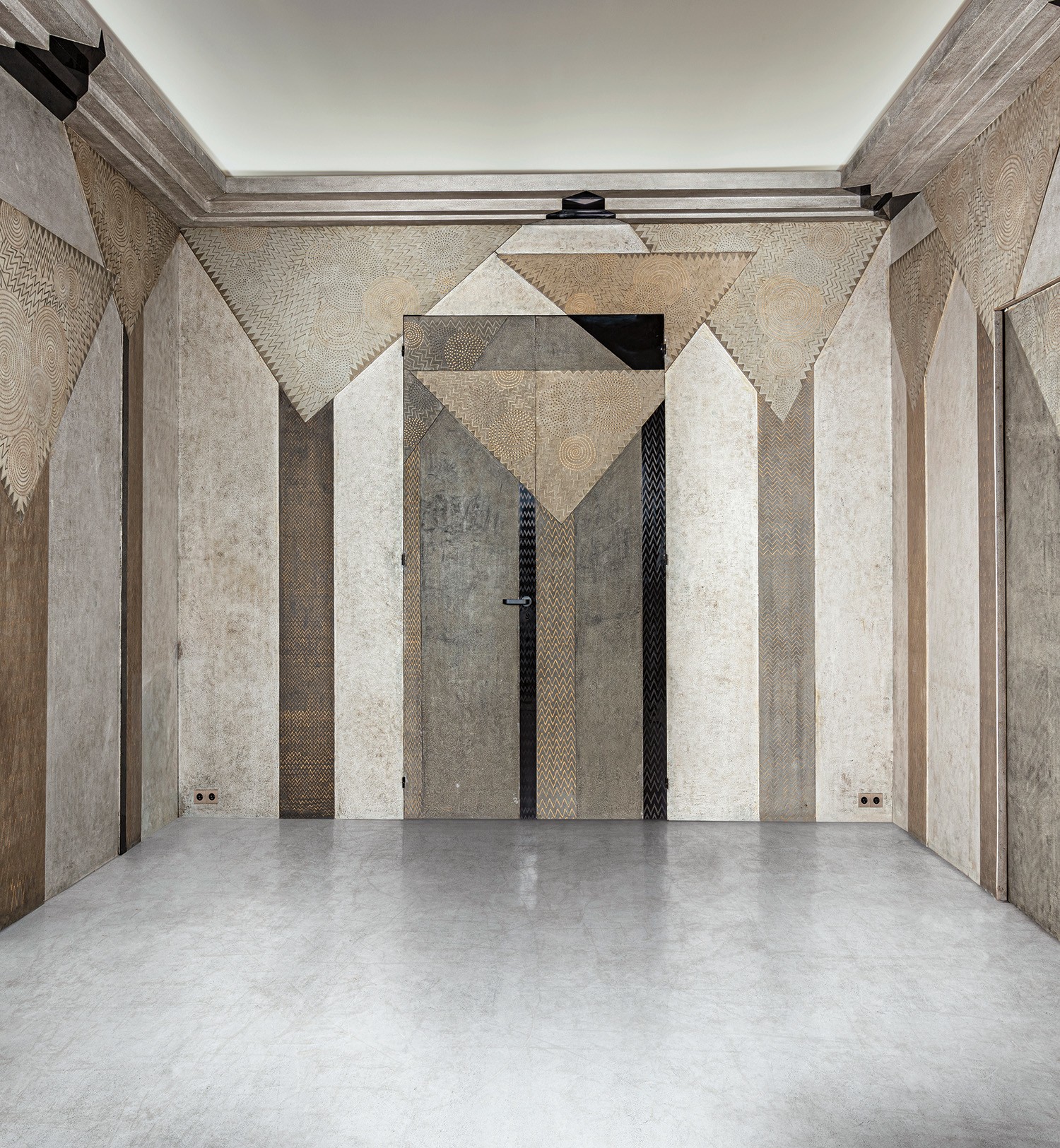

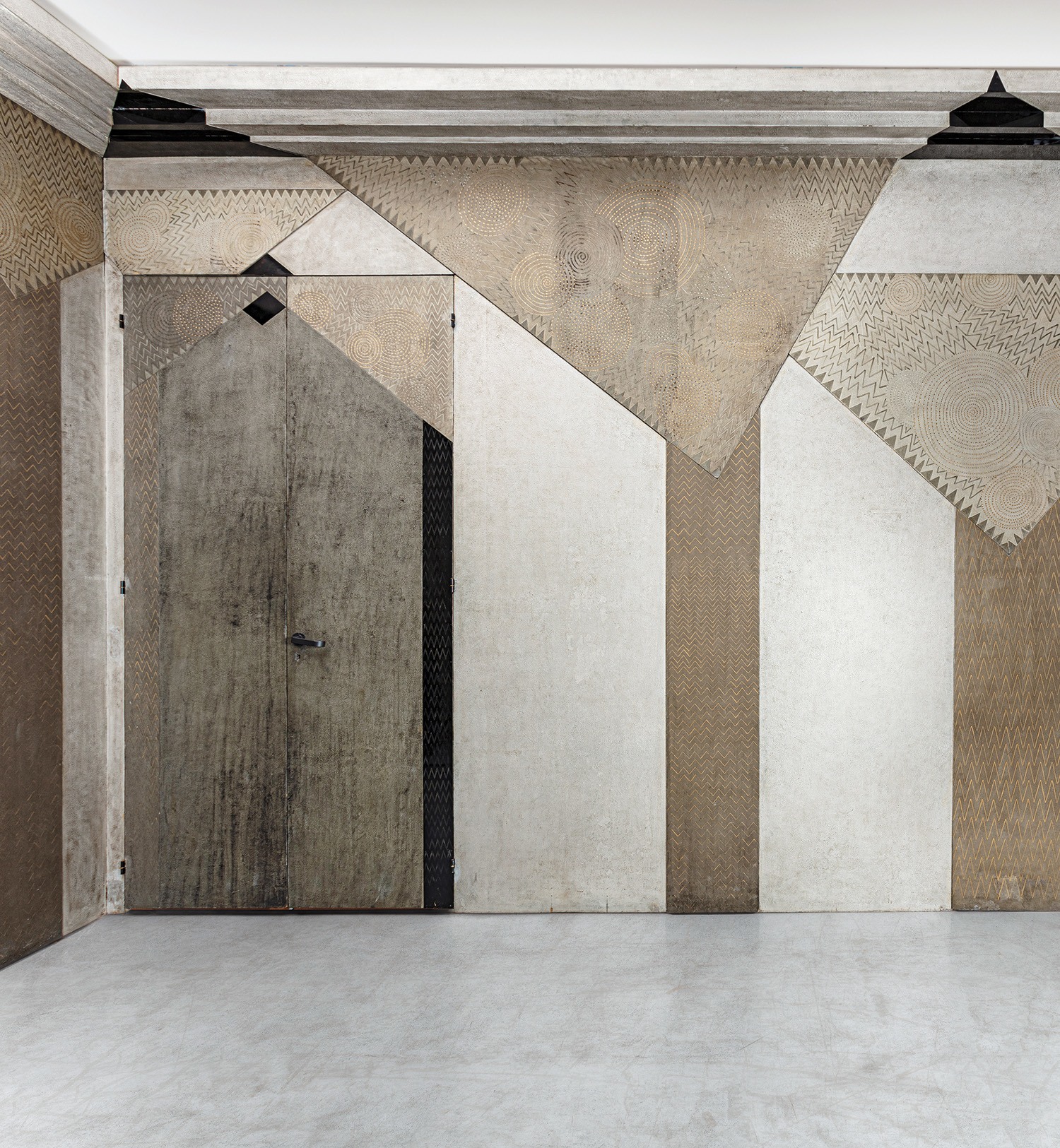

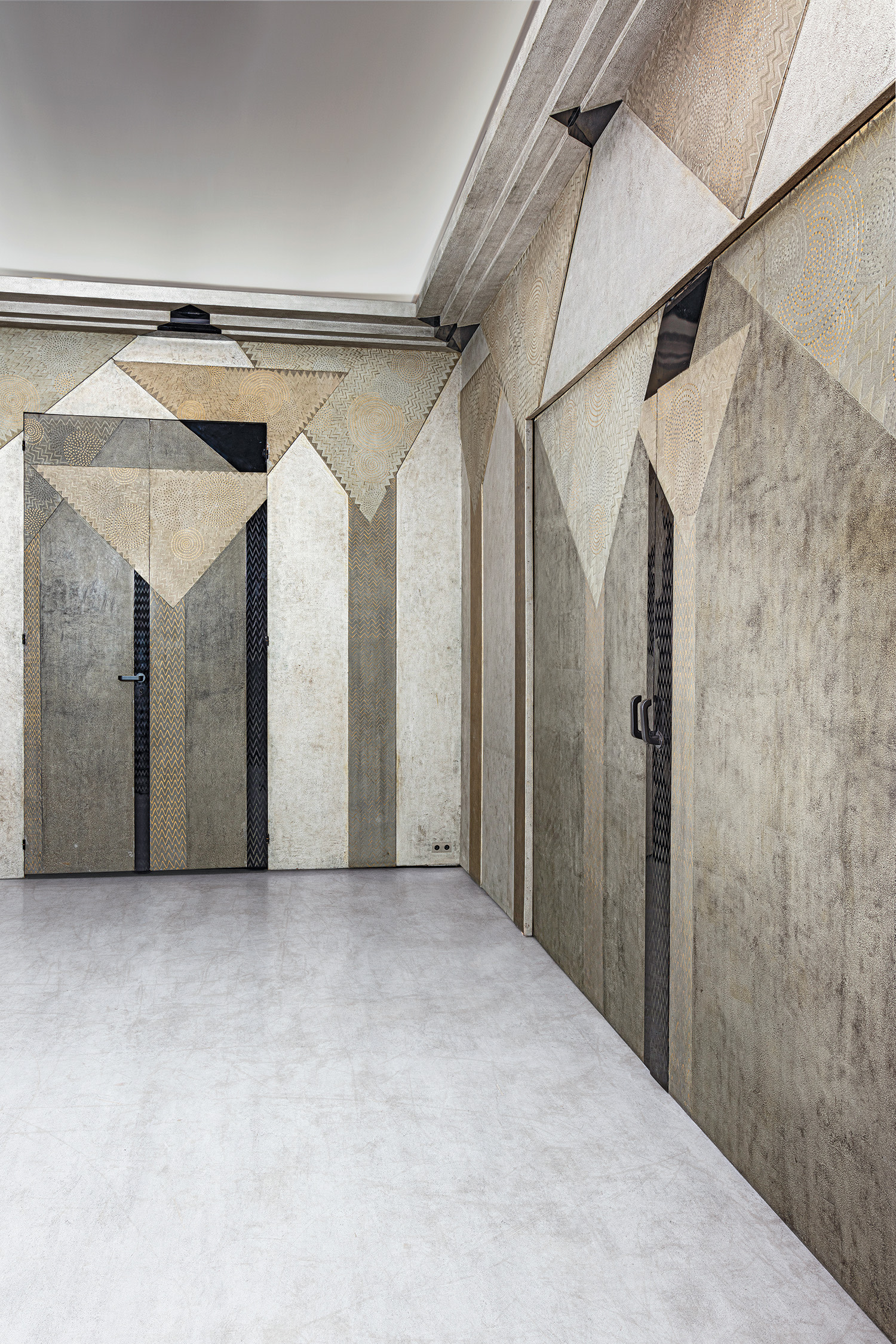
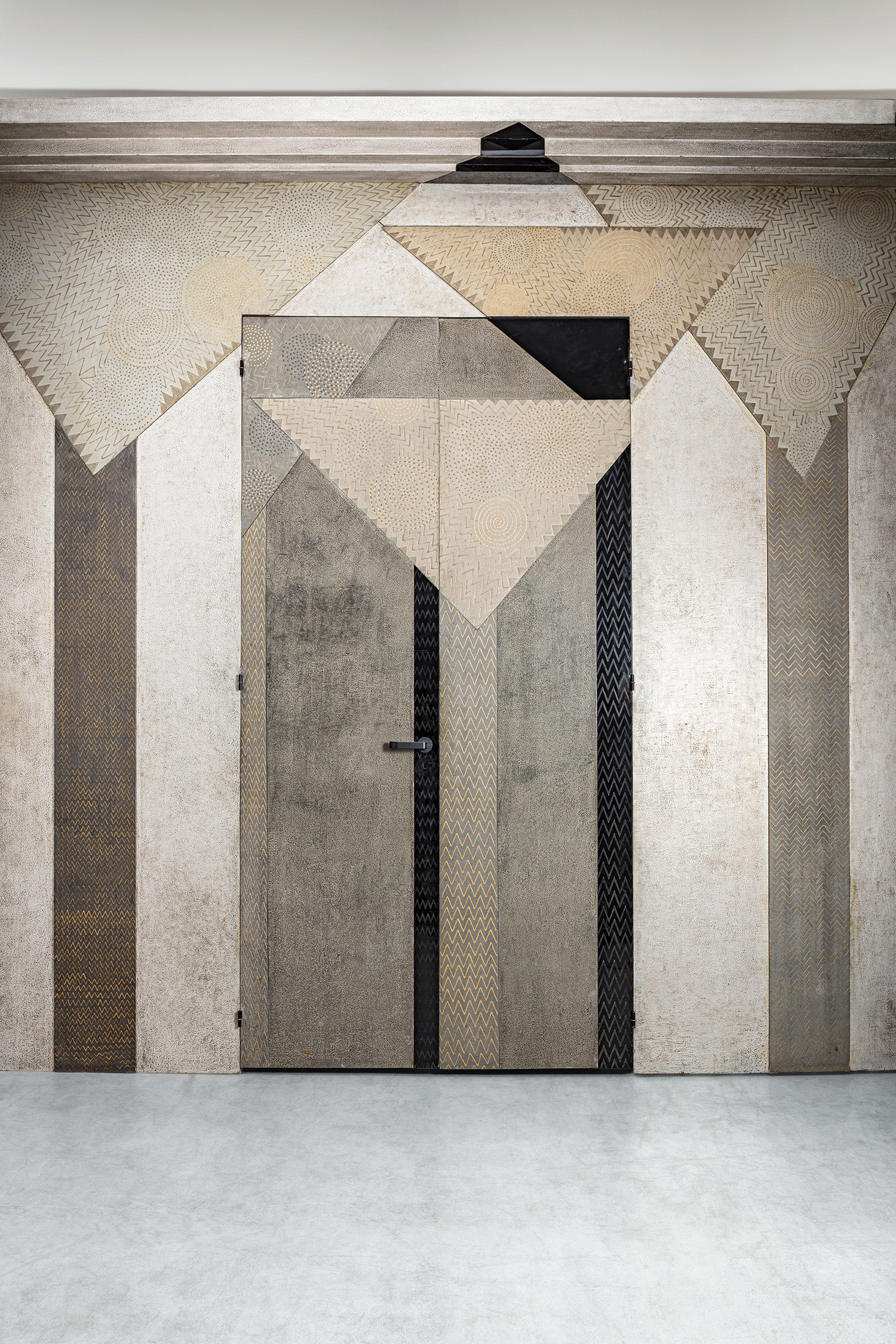

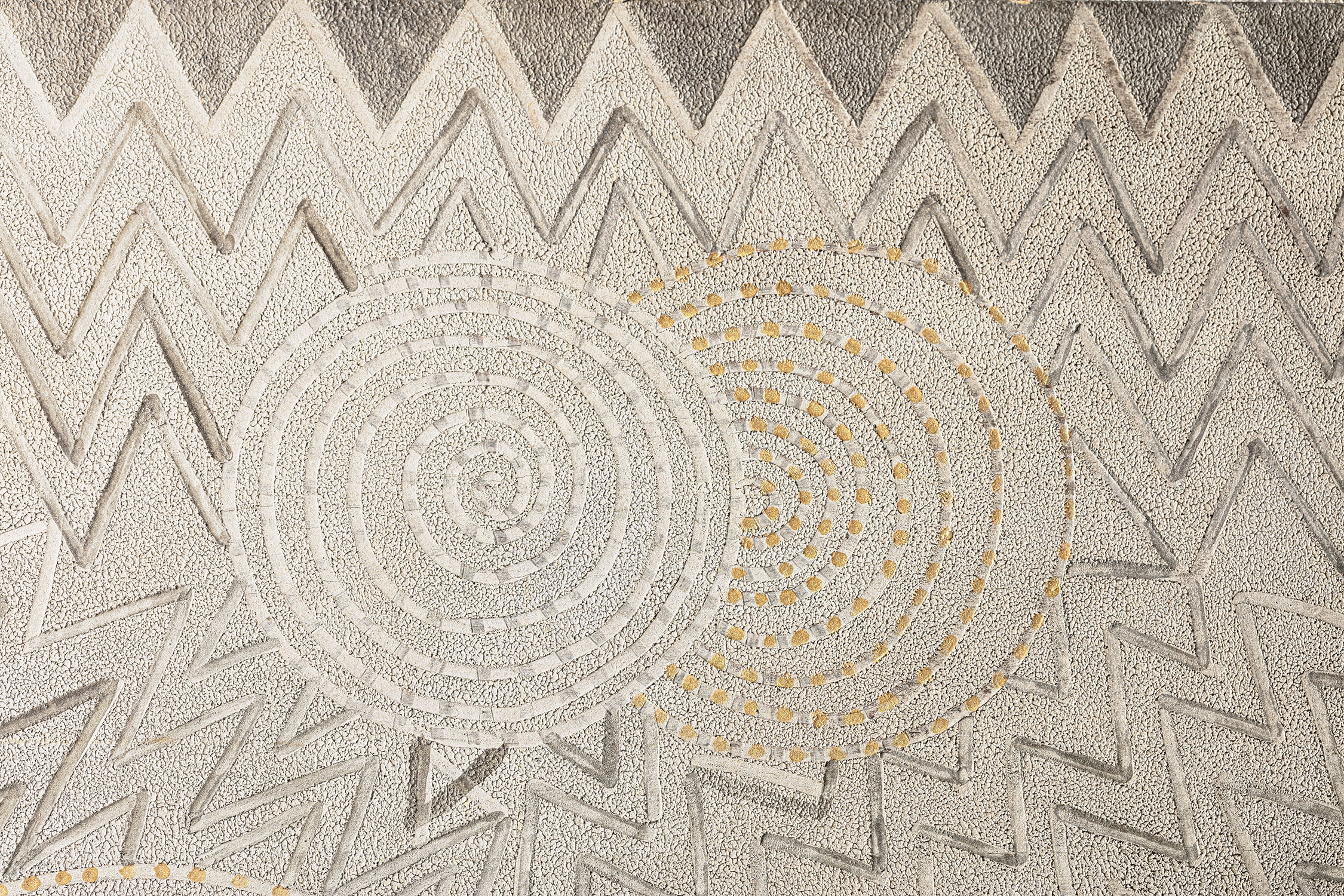














Property from an Important European Collection
33
Jean Dunand
‘Les Palmiers’ smoking room, from the residence of Mademoiselle Colette Aboucaya, Paris
1930-1936
Lacquered wood, lacquered metal, gilded wood.
Internal dimensions: 343 x 393 x 592 cm (135 x 154 3/4 x 233 1/8 in.)
One panel of north wall incised JEAN DUNAND.
Full-Cataloguing
Detailed technical drawing to be supplied with condition report.
Jean Dunand – Les Palmiers
By Amélie Marcilhac
Art Expert
In 1925, on the occasion of the International Exhibition of Modern Decorative and Industrial Arts held in Paris, for the first time Jean Dunand created lacquered wall-panels that delineated an entire room. As early as 1912, the dinandier had started dreaming in lacquer. Having taken lessons with the Japanese lacquer master Seizô Sugawara, Dunand realised numerous works in which this new material took precedence over the significance of copper and metal in his repertoire. In 1921, Dunand also began to create furniture incorporating lacquer and eggshell inlays.
Following from his new experiments in lacquer and having established a great reputation, Dunand was entrusted by Maurice Bokanowski, the president of the Société des Artistes Décorateurs, to design a 'smoking room for the private apartments' of the French Embassy pavilion for the 1925 International Exhibition. Measuring over three metres high, the walls were covered with black lacquered panels surmounted by a backlit silver lacquered ceiling, creating a cozy atmosphere. Positioned in the centre room were lacquer furniture and a central red and gold lacquered panel with two folds, the latter destined for the living room of the Marquise de Brantes.
Described at that time by the Journal des Arts Décoratifs as ‘a funeral smoking room, a retreat dreamed by hypochondriac smokers’, the room was nonetheless highly acclaimed by critics and inspired Madame Agnès to commission Dunand to design her studio at rue Saint-Florentin. The interior featured lacquered panels that recalled those of the smoking room, but now in textured gold, matte gold and gold laque arrachée. A few years later, the American patron Charles Templeton Crocker called upon Dunand to create three rooms for his residence in San Francisco: the breakfast room, covered with a motif of Japanese fish on a black lacquered background; the bedroom, decorated with does on a background of stylised vegetation; and the dining room, decorated with gold radiant lacquer.
Also, at the 1925 International Exhibition the coachbuilder Henri Binder exhibited his convertible cars, which integrated Dunand’s lacquerwork, comprising dashboards, interiors of doors, seats, handles that were partially or fully decorated with coquille d’œuf or laque arrachée. In 1928, the Aboucaya family, originally from Algeria, acquired Binder’s company. The coachbuilder continued his collaboration with Dunand, during which time the young Colette Aboucaya commissioned the designer to create the boiseries of the smoking room for her apartment in rue de Monceau. In accordance with Mademoiselle Aboucaya’s decorator Gérard Mille, Dunand designed a forest of stylised palm trees in tones of silver, gold and black lacquer with integrated lacquer metal plates, which added texture to the surface and extended the ‘palm grove’ to the cornices of the ceiling. Mille's furniture for the interior, also designed in black lacquer, was in perfect harmony alongside the creations of the Japanese artist Katsu Hamanaka, which combined black lacquer and tinted shagreen.
Dunand's decoration was inspired by a work he exhibited at the 1927 Salon des Artistes Décorateurs, which featured a scene of birds cooing on top of a stylised palm tree, which dominated the scene. The palm trees Dunand designed for Mlle Aboucaya’s smoking room, however, were far more developed; the textures of the different materials highlight the details of the design and the configuration en décroché of some of the palm trees creates a sense of depth to the entire scene, immersing the viewer within a palm grove of silver and black lacquer where one's gaze does not know where to land.
The present commission was completed in parallel with his design for the ‘Normandie’ ocean liner, which required much of Dunand and his workshop’s time and energy. Therefore, the smoking room for Colette Aboucaya was not finished until 1936. Following his father’s death, Bernard Dunand completed the decoration of the apartment, including an additional bedroom.
Les Palmiers de l’élégance: Quintessence de l’Art Déco
By Alexandra Jaffré
Art Historian and author of Seizô Sugawara, maître laqueur d’Eileen Gray
An invitation to travel... to sail through the waves of luxury in the vessel of modernity, this is what Jean Dunand promised to Mlle Colette Aboucaya when she commissioned the decoration of the smoking room of her Parisian apartment. When she discovered the final work installed, the patron could never have imagined this unique interior would enter the pages of the history of decorative arts as an iconic expression of French luxury. An expression of savoir-vivre, an appetite for modernity, a spirit of travel, a taste for the original and luxury: these are the ingredients that define the Art Deco period and that are united in the commission realised for this Parisian patron.
The savoir-vivre of the roaring twenties elevated the privilege of time to the level of art. The lacquering and sanding process are synonymous with patience and meticulous work, which can last for many months or even years depending on the ambition of the project. Once prepared the base then requires between ten and twenty layers of lacquer that need to be dried between each step and then sanded in a suitable environment. During this period, elite collectors understood that opulent interiors required patience on their part. In this smoking room—in which time is suspended among the billows of smoke—guests could find refuge far from the trepidation of city life, in an environment conducive to intimacy.
The appetite for modernity reigns in this interior in which Dunand created a decor characterised by vigorously geometric lines. This is the spirit of Art Deco, which worships the inventions of the engineer. However, the resulting strength is tempered by the softness of the powdered pink colour chosen for the furniture by the decorator Gérard Mille, which reflected the tones of the carpet by Ivan da Silva Bruhns. Dunand offered here with his masculine stylistic approach his own interpretation of the apartments of the hôtels particuliers during the reign of Louis XV, in which the ornamentation, consisting of organic curves enhanced by gold and colour, expressed an ode to femininity. Dunand adhered to the prayers of his intellectual contemporaries who aspired for the decorative arts to reach the same degree of excellence achieved during the eighteenth century, so that France could shine again in Europe. As such the masculine elegance of the present interior embodies the essence of French Art Deco.
Awaiting the host and his visitors, distant islands covered with palm trees can be reached by the gondola-shaped daybed. Born from Katsu Hamanaka's imagination, the refined lines of the daybed’s frame are covered with exotic shagreen and lacquered using the same-nuri technique, an alliance between yin and yang in the Far Eastern equilibrium. The solid and slender shape of the daybed evokes the Oceanian pirogues led by intrepid conquerors. It is difficult not to draw a parallel with the living room fully covered with lacquer panels and the pirogue designed a few years earlier by Eileen Gray for the millinery J. Suzanne Talbot. Gray and Dunand shared the same master, Seizô Sugawara, who taught them the ancestral techniques of lacquer, a closely guarded secret since immemorial times. They each transformed these techniques through the prism of modernity. Whilst Gray transferred her dreams of starlit spaces into lacquer, in the heart of Paris, Dunand transplanted an exotic cubist-inspired forest lacquered in silver, tempered with elements of gold and ochre. No figurative element disturbed the rhythm of the line and the circle, harmoniously combined by the symphony of tones. The decoration achieved a timelessness that becomes a support for an inner journey. Designed a few years after the 1925 International Exhibition, the interior’s decoration was the culmination of the smoking room Dunand had designed for the French Embassy, which had contributed to the glory of the exhibition.
Léon Aboucaya and his brother, the father and uncle of the patron, developed a taste for novelty and luxury having acquired the coachbuilding company of Henry Binder in 1928. Their ambition was to create the haute couture of automobiles. Executed in rare materials, each car was considered a work of art. The brothers entrusted Dunand’s workshop with the realisation of lacquer imitating shagreen or covered with gold and applied on modernist motifs. Because of the visual effect and durable qualities of the lacquer when applied to this symbol of freedom and speed, the master coachbuilders further elevated this material as an art of living. Therefore, it is not surprising to find that Mlle Colette Aboucaya shared this passion for lacquer, a noble and precious material which can be combined with gold, shagreen and mother-of-pearl. A poem for the eyes and an invitation to caress. Similarly, the wife of the coachbuilder Jean Henri-Labourdette commissioned Dunand to decorate the living room of her Paris apartment but in this case based on the exotic theme of hunting.
The modernity of the present smoking room was not conceived to please the most aristocratic members of the Parisian circles, who were conservative and cautious towards change. To mark their social standing and earn the acceptance of the upper classes, many industrialists and those who had made new fortunes preferred to build more classic collections focusing on eighteenth-century painting, furniture and objets d’art—a conservative and safe investment, but not very ambitious. A spirit of independence and contempt for commonly followed paths was required to resist this pressure. By choosing the bet of modernity, Mlle Colette Aboucaya belonged to a lineage of women who conquered the modern city. Among them were milliners, fashion designers and collectors who loved the freedom of movement of the body and were freed from convention; women such as Suzanne Talbot, Madame Agnès and Louise Boulanger who marked their time and who we continue to speak about today.
Admiring the elegant palm trees creates a suggestive force that transports the contemporary traveller to a parenthesis of French excellence: the Art Déco period. In their sap the eternal youth of modernist poetry flows.
Jean Dunand – Les Palmiers
By Amélie Marcilhac
Art Expert
In 1925, on the occasion of the International Exhibition of Modern Decorative and Industrial Arts held in Paris, for the first time Jean Dunand created lacquered wall-panels that delineated an entire room. As early as 1912, the dinandier had started dreaming in lacquer. Having taken lessons with the Japanese lacquer master Seizô Sugawara, Dunand realised numerous works in which this new material took precedence over the significance of copper and metal in his repertoire. In 1921, Dunand also began to create furniture incorporating lacquer and eggshell inlays.
Following from his new experiments in lacquer and having established a great reputation, Dunand was entrusted by Maurice Bokanowski, the president of the Société des Artistes Décorateurs, to design a 'smoking room for the private apartments' of the French Embassy pavilion for the 1925 International Exhibition. Measuring over three metres high, the walls were covered with black lacquered panels surmounted by a backlit silver lacquered ceiling, creating a cozy atmosphere. Positioned in the centre room were lacquer furniture and a central red and gold lacquered panel with two folds, the latter destined for the living room of the Marquise de Brantes.
Described at that time by the Journal des Arts Décoratifs as ‘a funeral smoking room, a retreat dreamed by hypochondriac smokers’, the room was nonetheless highly acclaimed by critics and inspired Madame Agnès to commission Dunand to design her studio at rue Saint-Florentin. The interior featured lacquered panels that recalled those of the smoking room, but now in textured gold, matte gold and gold laque arrachée. A few years later, the American patron Charles Templeton Crocker called upon Dunand to create three rooms for his residence in San Francisco: the breakfast room, covered with a motif of Japanese fish on a black lacquered background; the bedroom, decorated with does on a background of stylised vegetation; and the dining room, decorated with gold radiant lacquer.
Also, at the 1925 International Exhibition the coachbuilder Henri Binder exhibited his convertible cars, which integrated Dunand’s lacquerwork, comprising dashboards, interiors of doors, seats, handles that were partially or fully decorated with coquille d’œuf or laque arrachée. In 1928, the Aboucaya family, originally from Algeria, acquired Binder’s company. The coachbuilder continued his collaboration with Dunand, during which time the young Colette Aboucaya commissioned the designer to create the boiseries of the smoking room for her apartment in rue de Monceau. In accordance with Mademoiselle Aboucaya’s decorator Gérard Mille, Dunand designed a forest of stylised palm trees in tones of silver, gold and black lacquer with integrated lacquer metal plates, which added texture to the surface and extended the ‘palm grove’ to the cornices of the ceiling. Mille's furniture for the interior, also designed in black lacquer, was in perfect harmony alongside the creations of the Japanese artist Katsu Hamanaka, which combined black lacquer and tinted shagreen.
Dunand's decoration was inspired by a work he exhibited at the 1927 Salon des Artistes Décorateurs, which featured a scene of birds cooing on top of a stylised palm tree, which dominated the scene. The palm trees Dunand designed for Mlle Aboucaya’s smoking room, however, were far more developed; the textures of the different materials highlight the details of the design and the configuration en décroché of some of the palm trees creates a sense of depth to the entire scene, immersing the viewer within a palm grove of silver and black lacquer where one's gaze does not know where to land.
The present commission was completed in parallel with his design for the ‘Normandie’ ocean liner, which required much of Dunand and his workshop’s time and energy. Therefore, the smoking room for Colette Aboucaya was not finished until 1936. Following his father’s death, Bernard Dunand completed the decoration of the apartment, including an additional bedroom.
Les Palmiers de l’élégance: Quintessence de l’Art Déco
By Alexandra Jaffré
Art Historian and author of Seizô Sugawara, maître laqueur d’Eileen Gray
An invitation to travel... to sail through the waves of luxury in the vessel of modernity, this is what Jean Dunand promised to Mlle Colette Aboucaya when she commissioned the decoration of the smoking room of her Parisian apartment. When she discovered the final work installed, the patron could never have imagined this unique interior would enter the pages of the history of decorative arts as an iconic expression of French luxury. An expression of savoir-vivre, an appetite for modernity, a spirit of travel, a taste for the original and luxury: these are the ingredients that define the Art Deco period and that are united in the commission realised for this Parisian patron.
The savoir-vivre of the roaring twenties elevated the privilege of time to the level of art. The lacquering and sanding process are synonymous with patience and meticulous work, which can last for many months or even years depending on the ambition of the project. Once prepared the base then requires between ten and twenty layers of lacquer that need to be dried between each step and then sanded in a suitable environment. During this period, elite collectors understood that opulent interiors required patience on their part. In this smoking room—in which time is suspended among the billows of smoke—guests could find refuge far from the trepidation of city life, in an environment conducive to intimacy.
The appetite for modernity reigns in this interior in which Dunand created a decor characterised by vigorously geometric lines. This is the spirit of Art Deco, which worships the inventions of the engineer. However, the resulting strength is tempered by the softness of the powdered pink colour chosen for the furniture by the decorator Gérard Mille, which reflected the tones of the carpet by Ivan da Silva Bruhns. Dunand offered here with his masculine stylistic approach his own interpretation of the apartments of the hôtels particuliers during the reign of Louis XV, in which the ornamentation, consisting of organic curves enhanced by gold and colour, expressed an ode to femininity. Dunand adhered to the prayers of his intellectual contemporaries who aspired for the decorative arts to reach the same degree of excellence achieved during the eighteenth century, so that France could shine again in Europe. As such the masculine elegance of the present interior embodies the essence of French Art Deco.
Awaiting the host and his visitors, distant islands covered with palm trees can be reached by the gondola-shaped daybed. Born from Katsu Hamanaka's imagination, the refined lines of the daybed’s frame are covered with exotic shagreen and lacquered using the same-nuri technique, an alliance between yin and yang in the Far Eastern equilibrium. The solid and slender shape of the daybed evokes the Oceanian pirogues led by intrepid conquerors. It is difficult not to draw a parallel with the living room fully covered with lacquer panels and the pirogue designed a few years earlier by Eileen Gray for the millinery J. Suzanne Talbot. Gray and Dunand shared the same master, Seizô Sugawara, who taught them the ancestral techniques of lacquer, a closely guarded secret since immemorial times. They each transformed these techniques through the prism of modernity. Whilst Gray transferred her dreams of starlit spaces into lacquer, in the heart of Paris, Dunand transplanted an exotic cubist-inspired forest lacquered in silver, tempered with elements of gold and ochre. No figurative element disturbed the rhythm of the line and the circle, harmoniously combined by the symphony of tones. The decoration achieved a timelessness that becomes a support for an inner journey. Designed a few years after the 1925 International Exhibition, the interior’s decoration was the culmination of the smoking room Dunand had designed for the French Embassy, which had contributed to the glory of the exhibition.
Léon Aboucaya and his brother, the father and uncle of the patron, developed a taste for novelty and luxury having acquired the coachbuilding company of Henry Binder in 1928. Their ambition was to create the haute couture of automobiles. Executed in rare materials, each car was considered a work of art. The brothers entrusted Dunand’s workshop with the realisation of lacquer imitating shagreen or covered with gold and applied on modernist motifs. Because of the visual effect and durable qualities of the lacquer when applied to this symbol of freedom and speed, the master coachbuilders further elevated this material as an art of living. Therefore, it is not surprising to find that Mlle Colette Aboucaya shared this passion for lacquer, a noble and precious material which can be combined with gold, shagreen and mother-of-pearl. A poem for the eyes and an invitation to caress. Similarly, the wife of the coachbuilder Jean Henri-Labourdette commissioned Dunand to decorate the living room of her Paris apartment but in this case based on the exotic theme of hunting.
The modernity of the present smoking room was not conceived to please the most aristocratic members of the Parisian circles, who were conservative and cautious towards change. To mark their social standing and earn the acceptance of the upper classes, many industrialists and those who had made new fortunes preferred to build more classic collections focusing on eighteenth-century painting, furniture and objets d’art—a conservative and safe investment, but not very ambitious. A spirit of independence and contempt for commonly followed paths was required to resist this pressure. By choosing the bet of modernity, Mlle Colette Aboucaya belonged to a lineage of women who conquered the modern city. Among them were milliners, fashion designers and collectors who loved the freedom of movement of the body and were freed from convention; women such as Suzanne Talbot, Madame Agnès and Louise Boulanger who marked their time and who we continue to speak about today.
Admiring the elegant palm trees creates a suggestive force that transports the contemporary traveller to a parenthesis of French excellence: the Art Déco period. In their sap the eternal youth of modernist poetry flows.